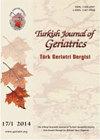老年人汞合金充填量与认知的关系
IF 0.3
4区 医学
Q4 GERIATRICS & GERONTOLOGY
Turkish Journal of Geriatrics-Turk Geriatri Dergisi
Pub Date : 2023-03-01
DOI:10.29400/tjgeri.2023.334
引用次数: 0
摘要
简介:本研究旨在评估老年人牙汞合金充填与认知的关系。材料与方法:从某老年门诊共招募169例65岁及以上患者。记录了他们的社会人口统计学和慢性病数据。所有患者均行口腔检查。对使用汞合金充填物的个体计算汞合金充填指数得分。根据他们的汞合金填充状态,参与者被分为研究组[汞合金(+)]和对照组[汞合金(-)]。在亚分析中,汞合金填充组按照高(≥4.191)和低(0.05)进行分类,或者按照汞合金填充组中汞合金得分高和低的参与者之间的所有测试分数进行分类。结论:本研究表明,牙科汞合金填充物与老年人认知能力下降无关。关键词:年龄;认知功能障碍;银汞合金。本文章由计算机程序翻译,如有差异,请以英文原文为准。
Relationship Between the Amount of Amalgam Filling and Cognition in Older Adults
Introduction: This study aimed to evaluate the relationship between dental amalgam filling and cognition in older adults. Materials and Methods: A total of 169 patients aged 65 years and above were recruited from a geriatric outpatient clinic. Their socio-demographic and chronic disease data were recorded. All patients underwent oral examinations. Amalgam filling index scores were calculated for individuals with amalgam fillings. The participants were divided into a study group [amalgam (+)] and a control group [amalgam (–)] based on their amalgam-filling statuses. For sub-analysis, the amalgam-filled group was categorised according to high (≥4.191) and low (<4.191) mean index scores. Standardised mini-mental test, clock drawing test and Lawton–Brody instrumental activities of daily living scale were conducted for all patients. Results: About 46.2% (n=78) of participants were female, mean age was 69.6 ± 6.3 years and 53.7% (n=89) had amalgam fillings. There was no significant difference in the standardised mini-mental test, clock drawing test and Lawton–Brody instrumental activities of daily living scale scores between the study and control groups (all p>0.05), or in all test scores between participants with high and low amalgam scores in the group with amalgam fillings. Conclusions: This study showed that dental amalgam fillings were not associated with cognitive decline in older adults. Keywords: Aged; Cognitive Dysfunction; Dental Amalgam.
求助全文
通过发布文献求助,成功后即可免费获取论文全文。
去求助
来源期刊

Turkish Journal of Geriatrics-Turk Geriatri Dergisi
GERIATRICS & GERONTOLOGY-
CiteScore
0.60
自引率
0.00%
发文量
46
审稿时长
6-12 weeks
期刊介绍:
Turkish Journal of Geriatrics is a peer-reviewed journal. Official language of the journal is English. Turkish Journal of Geriatrics invites submission of Original Articles based on clinical and laboratory studies. Review Articles are published only after the invitation from the Editorial Board.
 求助内容:
求助内容: 应助结果提醒方式:
应助结果提醒方式:


